By Ellie Wolf
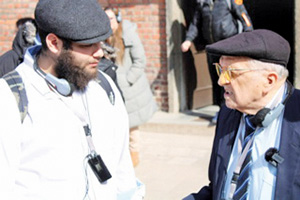
Dov Landau.
This year, as in years past, members of the MTA senior class participated in the ‘Names, Not Numbers©’ Oral History Project. A recent outgrowth from this experience, the ‘Names, Not Numbers©’ Poland trip, had begun before the pandemic and finally resumed this year. Mendy Zisman, an MTA alumnus of the program, served as a madrich and noted solemnly that the trip was not the classic “March of the Living” or gap-year trip. Rather, the Poland trip is exclusively for participants in the ‘Names, Not Numbers©’ senior elective course, and is a “Leadership Training Chesed Mission.”
“We visited Holocaust sites in Poland and also had educational sessions with individuals and leaders in organizations in Poland that are fighting antisemitism and promoting Jewish cultural education and activities to the Polish non-Jewish people,” said Zisman. “We interacted with leaders in the Jewish world, educators and rabbis, and had a chance to discuss the future of the Jewish community and the special activities that are done.”
Zisman described walking through Auschwitz with Holocaust survivor Dov Landau as an emotional experience. “I am not sure who was holding on tighter as we held onto each other for support. For this survivor, it was confirmation that not only had he survived, but his memories and experiences will never be forgotten by future generations,” Zisman shared. He pointed out that this is part of what fulfilled the purpose of their ‘Names, Not Numbers©’ Holocaust Oral History Film Documentary project. “For me, listening to him speak next to the barracks where he slept brought all I had heard and learned about the Holocaust to life. While I will never fully understand the horrors and loss the Jewish people endured, visiting Auschwitz gave me more insight about what happened. … History was brought to life for me.”
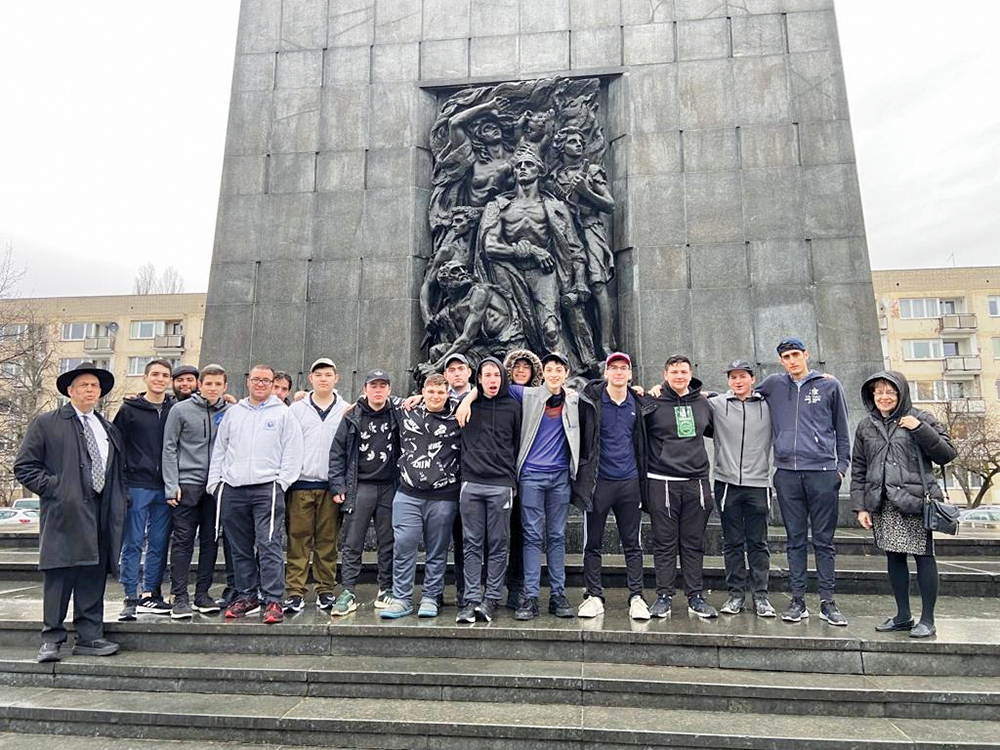
Commenting on the site of the Majdanek camp, “I was shocked to see how close the camp’s location was to the surrounding homes. Like Central Park in New York City, Majdanek is perched in the center of the city, right off the main road. You can see the vast fields and buildings,” Zisman said, separated only by the tall barbed wire fences. “There is no possible way the people in the city did not know what was happening.
“One memorable experience at Majdanek camp was saying Kaddish and singing ‘Ani Ma’amin’ next to the tremendous pile of ashes, a representation of our ancestors,” the guide continued. “We need to educate and bring awareness about the Holocaust and the damage that hate and ignorance can do. As there are fewer and fewer survivors to give testimony to the atrocities they experienced, it is up to us to make sure their stories and legacies live on. This trip took us in the footsteps of the ancestors we lost and also allowed us to be upstanders for the future. This is the mission of the ‘Names, Not Numbers©’ organization, and I have tremendous hakaras hatov to Tova and Dov Rosenberg for the opportunity to take part in such an important and unique program.”
As the madrich and having previously visited these sites, Zisman said he felt more prepared for the intense emotions involved and was able to focus better on “being there” for the students as they confronted the experience for the first time, helping them internalize what they were witnessing and learning.
MTA senior Aaron Sisser shared: “I will never forget the first time that I saw a concentration camp with my own eyes. When we came to Majdanek, it was jarring to see how this camp was in the middle of the city. There were buildings on either side; then all of a sudden, a wide expanse that served as the killing grounds for hundreds of thousands of people. Walking through the grounds in the cold winds, I could not even begin to imagine what it must have felt like to walk through this place as an underfed, under-clothed, abused prisoner.
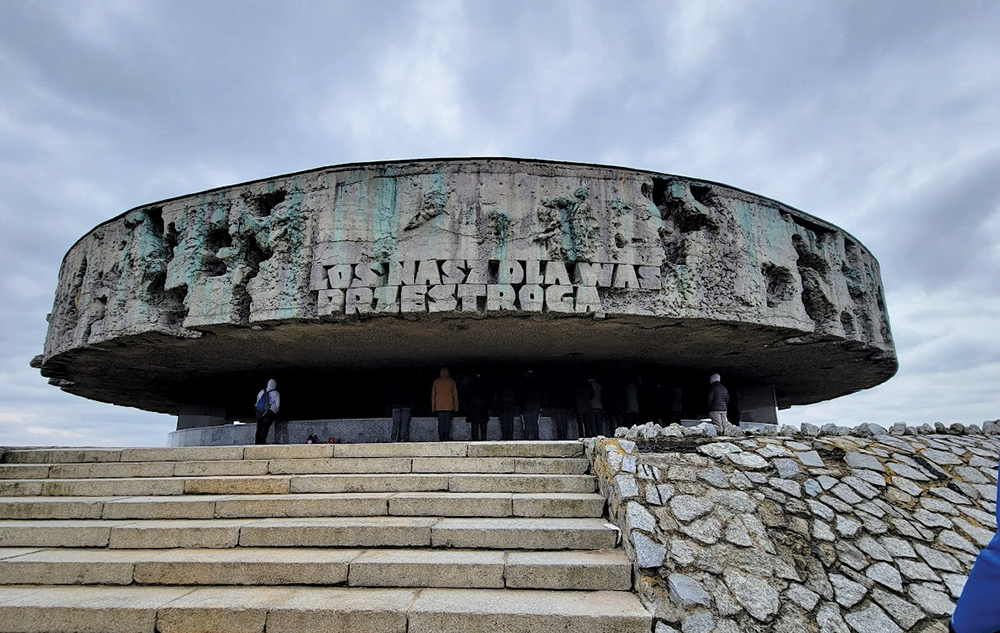
(Credit: Avi Zisman)
“It was at Majdanek that I first truly began to understand how the Nazis treated the Jews like filth, as if they were an abomination to society, not even human,” Sisser continued. “We came to the gas chambers, and looked into the room where so many people had their lives taken from them. Everyone was in silent shock as we moved on to the crematorium, where the corpses were taken and made into ash. Still too stunned to speak, we were left in utter disbelief at the methods that were used to exterminate human beings.
“Then we went to a mountain in the distance. As we got closer, we understood that this was not a natural mountain nor an artificial monument, but rather a memorial made out of human ash and bones; the ash and bones that remained when the camp was finally liberated. It was hard to come to terms with the fact that this mountain of ash used to be part of living, breathing human beings. In response, all we could do was sing hopeful songs about the eventual redemption of the Jewish people.
“This experience left an imprint on me that I will never forget. It is our job to continue telling the stories of those who lived through this terrible time and those who perished, and to honor their lives and memories. We must never forget the tragedy that occurred, hoping for peace in the years to come.
“I left Poland with a lasting desire to do good and bring kindness into the world,” the MTA student continued. “Throughout the trip, we saw how the actions of individuals could have such a huge impact on so many people. We heard from a righteous gentile, who put herself at risk to save Jews during the Holocaust. … We visited the factory of Oskar Schindler. That people put the needs of others above their own really inspires me.
Sisser concluded: “When I think back on my trip to Poland, I think of all of these people who go out of their way to help others. Terrible things can happen if people do not treat each other with kindness and respect. Yet it is inspiring to see the good that people can do if they focus on helping others.”
Natan Horowitz said that going to the Majdanek concentration camp was the closest he has come to understanding the Holocaust and its magnitude. “The camp is completely intact; you can see every barrack and every guard tower. You can walk inside the actual gas chamber and crematorium, and see the Zyklon B stain on the walls. On top of a hill next to the crematorium is a large dome under which is a mountain of dirt in which all of the ashes of the victims were buried. That was probably the most emotional moment in the whole trip for me: standing before the Valley of Dry Bones.
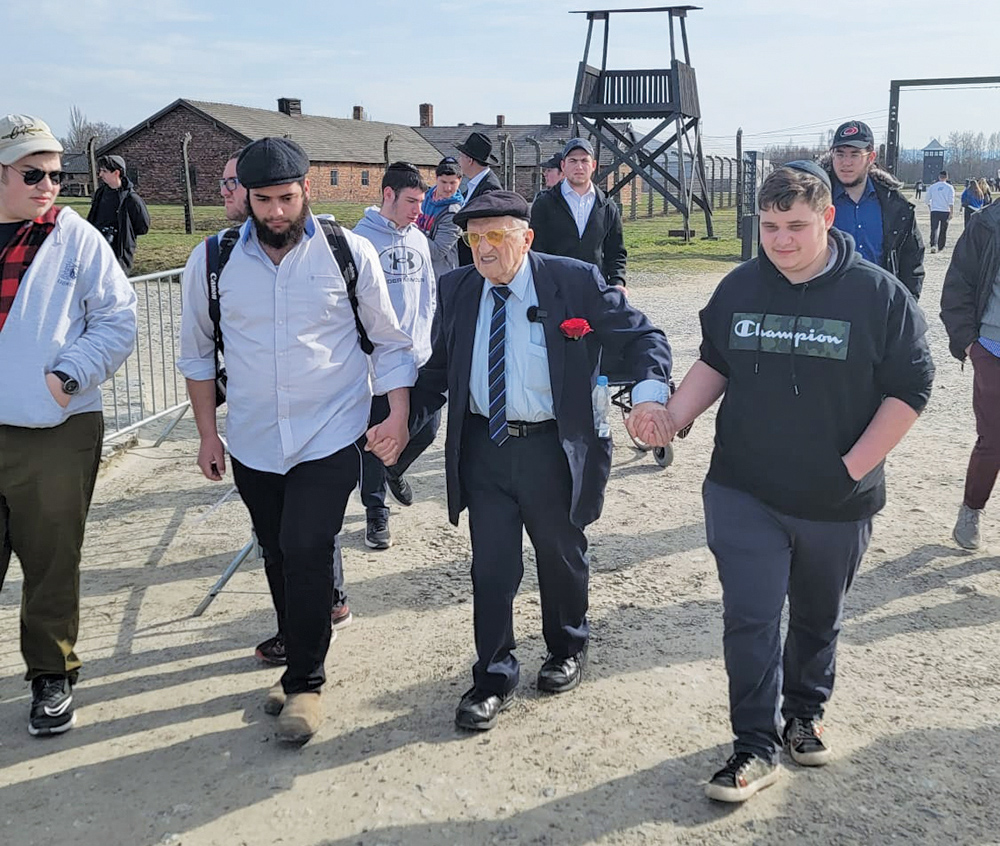
“In truth, we will never fully understand the Holocaust or its magnitude,” Horowitz added. “There is a reason why over 80 years later there are still historians who have dedicated their whole lives to discovering more about what happened during those years of Gehennom on earth.
“While we might not be able to fully understand the Holocaust, we can begin to understand how we reacted in its aftermath, how the survivors did not just ‘survive,’ but rather they rebuilt and revived a broken nation. We just celebrated the 75th anniversary of the creation of the State of Israel, a return to Jewish sovereignty in the Land of Israel that had not occurred in over 2,000 years since the Ḥashmonaim. And it happened three years after the Holocaust.
“In Israel and around the world our communities are blooming,” Horowitz noted. “We are rebuilding the 6 million lost, continuing their memory and passing on the stories of those who survived so that the world and we will truly Never Forget.”
Student participant Avi Cohn shared: “My most prominent impression of the trip was that every Jew is a Jew—no matter what. If you had Jewish blood, Hitler wanted to kill you. Period. As you walk through Poland you see all different kinds of Jews from different places and all you can think is, ‘Why can’t we view ourselves the same way? Why can’t we as a Jewish nation welcome everyone?’ For example, I am a Cohen and couldn’t go into the Warsaw cemetery. So I sat outside and spoke to many of the other groups, kids who are my age, some traditional, and most not religious. But we all have something in common: that we’re Jewish. A Jew is a Jew, and we have more in common than we have different.
“At the exhibit in the Majdanek concentration camp there were Chasidim there, too,” Cohen continued. “I got into a conversation with one kid and he explained that they were in Poland for a rebbe’s yahrzeit, and he was from a yeshiva in Bnei Brak. At the end of this conversation we both realized we look completely different and are from two totally different sides of Judaism. But we both agreed on the main point: A Jew is a Jew no matter what. We are persecuted as one nation whether we look Jewish or not; the same way we all need to be one big Jewish nation and bring Moshiach, together as one Jewish people.”
Tova Fish-Rosenberg, creator of the ‘Names, Not Numbers©’ oral history film documentary project, accompanied the students to Poland. She also addressed the importance of perpetuating the project and discussed her vision for the future.
“We must never forget the living memorials in our midst, the final generation of survivors. We must afford as many students as possible the opportunity to hear the eyewitness testimonies. It is only through these testimonies that we can ensure that the generations to come will be educated through these face-to-face interviews.”
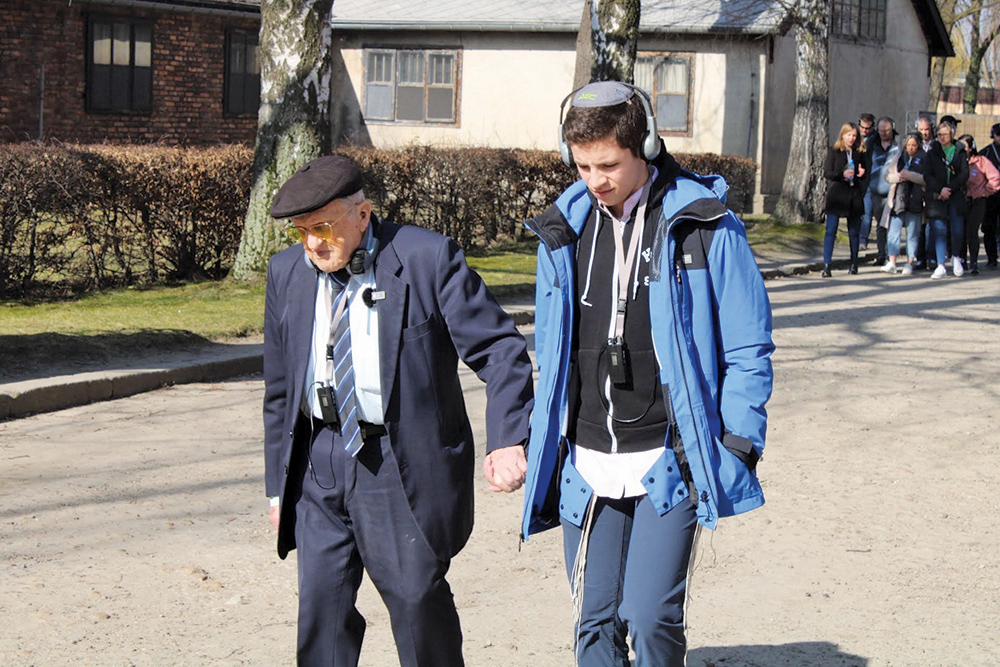
Rosenberg noted that Dr. Michael Berenbaum, Holocaust scholar, former president and CEO of the Shoah Foundation, former director of the US Holocaust Research Center at the United States Holocaust Memorial Museum and ‘Names, Not Numbers©’ board member, wrote to the students: “You are a transitional generation. You are witnesses to the witnesses—the last people to live in the presence of survivors. You’re giving them a story—a narrative that reverses the process of dehumanization which they experienced during the war.”
“We are creating additional educational platforms to use the ‘Names, Not Numbers©’ testimonials to educate future generations, adding programs that teach students about the importance of being an upstander, and working to make the world safe for all people, regardless of race, religion and creed,” continued Rosenberg.
For example the program has now expanded to the public schools. At one school that participated in the project, the student speaker concluded: “Understanding history, respect for humanity and intolerance of hate are timeless lessons. We are grateful to have had the opportunity to learn directly from living survivors. As young students and the future leaders of tomorrow we need to continue to share a story that cannot be forgotten and we must make sure an event like this never happens again. Ladies and gentlemen, our lessons today are the hope for tomorrow’s world.”
The MTA trip to Poland is an example of the additional educational platforms about which Rosenberg spoke. “These unique trips are not ‘March of the Living’ trips. They are leadership training/chesed missions that have been life-changing for all of the participants. The impact of walking through the places that represent hundreds of years of Polish Jewish history and ended with the Holocaust is indescribable. We stood in the places of famous rabbis and visited towns where so many famous Jews left an impact on our culture and gave so much to society. Now, the artifacts and pictures that we were seeing in museums are staring at us. The pictures of the children playing, studying in the cheder and yeshivas, their parents in the streets and at their jobs come alive.”
Rosenberg added that walking with Rabbi Taubes, Landau, the guides and lecturers connected their explanations and stories to each location and embedded it in their collective memory. “Coupled with what we have learned from the survivors, their stories and their resilience will never be forgotten. They are truly role models for all of us.
“Every day and at every site, the students shared their reflections,” Rosenberg continued. “They sang and danced and showed their deep emotions for everything they saw and learned.”
Rosenberg concludes by saying that they had achieved the goals for the trip, and now those students will “shoulder the responsibility” to be upstanders by implementing change in the world through education.
Rabbi Michael Taubes, rosh yeshiva of MTA and REITS and rabbi of Congregation Zichron Mordechai has accompanied the seniors on this trip four times, “One of the central themes … was also to observe the current revival of the Jewish community in post-World War II Krakow,” he said. “It was inspiring to see how the community has rebuilt itself. “There is a vibrant Jewish community center, and [Krakow] now has a rabbi, Rabbi Avi Baumol. In Krakow, he spoke with us at the JCC. The Assistant Chief Rabbi [of Poland] Yehoshua Ellis spoke to us in Warsaw, where there is also a fully functioning school.” We davened and I was privileged to give a shiur in the very synagogue of the Rema, Rabbi Moses Isserles of Krakow. Centuries of rabbinic leadership thrived in Poland.” Rabbi Ellis also shared with the students that some Poles discovered that their 90-plus-year-old grandparents were actually Jewish!
Rabbi Taubes also remarked about how sobering it was to observe the camps that are fully intact, and situated within clear view of the residential areas of the cities. Only the Belzec camp has been basically obliterated. “There is no comparison for the students between learning about the Holocaust and hearing stories in school or at home, and the actual experience of being at the camps live and in person. It was powerfully moving and highly emotional for the students to recite Kaddish at the mound of ash and bones at Majdanek, one of the largest extermination camps. “We also sang ‘Acheinu and Ani Ma’amin,’ and recited passages from Tanach, connecting events, people and Halacha. We attended a memorial service conducted by the Polish community of Lublin on the anniversary of the deportation of the Jews, commemorating those who were lost.”
Rabbi Taubes mentioned a little-known fact that “although many Poles certainly collaborated with the Nazis against the Jews, many Poles also hid Jews, and Poland was the only country where righteous rescuers and their families under the puppet Nazi government were executed, as Germany hated the Poles as well.”
Student participant Noach Spear shared something that impressed him: seeing different types of Jews visiting the sites of the Holocaust. “It showed how it affected all Jews, that people really do care and want to come learn first-hand about what happened not so long ago.
“Although learning about the Holocaust is difficult, it’s important to understand where you came from, so that you can use that knowledge to show proper love to all different types of Jews and people.”
Spear concluded, noting that the trip was inspiring, “but would be meaningless if we don’t act on that inspiration as a community.”
Ellie Wolf is a Jewish Link staff writer who covers a spectrum of community events, business spotlights, and a broad base of health topics. She is also a biofeedback specialist, serving clients in two local psychology practices and specializing in pain management, anxiety, insomnia and a spectrum of health issues. In addition, she conducts training for mikvah attendants and works privately with individuals who struggle with fear in the water. She can be reached at [email protected]












